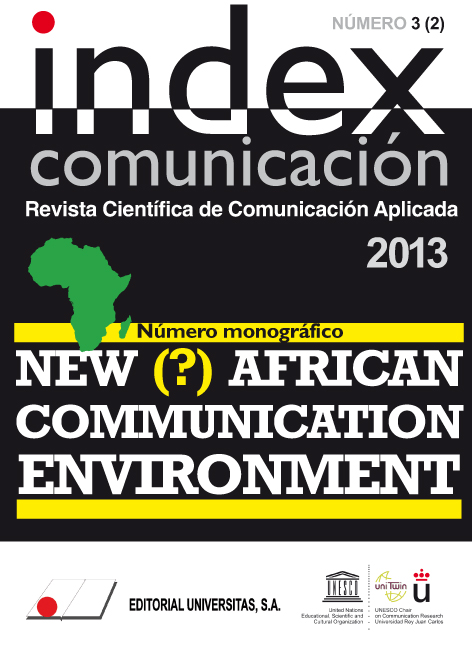Encountering Otherness. Depth of Field: A collective approach to Africa
Keywords:
photography postcolonial Africa, representation, Otherness, postmodern artAbstract
The purpose of this article is to approach postcolonial African photography through the pictures of the Nigerian group DOF (Depth of Field), in terms of what has been called Trans-African Photography; a photography that brings down the borders of the African continent and denies the identitary aspects of “the African” as a Western construction. The pictures of this new generation keep no relation with such characteristics as the naïve, the primitive or the brute, all of them related to “the African” from the point of view of the West. On the contrary, they insert themselves into the global dialogue of the Postmodern Art. And by doing so, they break away from the omnipresent ethnocentrism in the arts. It is important to raise this topic in the academia in order to create legitimization for these artistic practices that question not only the art circle and its system but also the social construction of an imagery that is currently widespread in the Western Countries. The training of these photographers has taken place mostly in Europe. Therefore talking about the migratory flux of the art and its meanings becomes necessary as well. The pictures of DOF, rather than represent the Other, raise controversy about the pertinence of Africa being part of a globalised world distributes their artworks and, at the same time, relocates them away from their territory. This has caused a great split not only in the western imagery but also in more traditional-style African photographers such as J.D. ‘Okhai Ojeikere, Tam Fiofori, Jide Adeniyi-Jones y Sunmi Smart-Cole.
Metrics
References
Barrientos Rodríguez, J.; Bal, M. & Hernández, M. A. (2012): Art and Visibility in Migratory Culture: Conflict, Resistance, and Agency. Amsterdam and New York: Rodopi.
Barthes, Roland (1977): Rethoric of the Image (Image-Music-Text). Glasgow: Fontana Press.
Baumann, G. & Gingrich, A. [Eds.] (2004): Grammars of Identity / Alterity: A Structural Approach. Oxford, New York: Berghahn Books.
Bekers, Elisabeth [Ed.] (2009): Transcultural Modernities: Narrating Africa in Europe. Amsterdam: Rodopi.
Bück-Morss, S. (1992): ‘Aesthetics and Anaesthetics: Walter Benjamin’s Artwork Essay Reconsidered’. October 62, pp. 3-41.
Danto, Arthur (2003): The Abuse of Beauty: Aesthetics and the Concept of Art. Chicago: Open Court Publishing.
Derrida, Jacques (1978): Writting and difference. Chicago: University of Chicago Press.
Foucault, M. (1988): ‘The subject and Power’, in Critical Inquiry, 8:4, pp. 775-798.
Foucault, M. (2004): Abnormal: lectures at the Collège de France 1974-1975. London and New York: Verso.
Freeborn, O. (2005): ‘The Crisis of Appropriating Identity for African Art and Artists: The Abayomi Barber School Responsorial Paradigm’, in Gefame, Journal of African Studies, 2(1). Retrieved June 28, 2013 from: http://hdl.handle.net/2027/spo.4761563.0002.103
Gaafar, Rania (2011): ‘Migrating Forms: Contemporary African Photography at The Walther Collection’, in Third Text, 25(2), pp. 241-247.
Hall, Stuart (1997): The Spectacle of the Other. In Representation: Cultural Representations and Signifying Practices (223-290). London: SAGE.
Lévi-Strauss, Claude (1983): Le regard éloigné. París: Plon.
Macdonald, S. J. (2004): ‘Museums, National, Postnational and Transcultural Identities’, in Messias Carbonell, B.: Museum Studies: An Anthology of contexts, pp. 223-286. Malden, MA: Blackwell.
McRobbie, A. (1994): Posmodernism and Popular Culture. London: Routledge.
Nkenm-Eneanya, J. (2013): ‘Kelechi Amadi-Obi: The Lawyer and the Lens’, in KonnectAfrica Magazine Online, March 27, 2013. Retrieved June 2, 2013 from: http://www.konnectafrica.net/2013/03/27/kelechi-amadi-obi-the-lawyer-and-the-lens/
Okereke, Emeka (2012): Artscape: The new African photography [video]. Lagos: Al Jazeera. Retrieved July 1, 2013 from: http://www.aljazeera.com/programmes/artscape/2013/04/2013421133119858694.html
Oloidi, O. (2011): Rejected Stone: Visual Arts in an Artistically Uninformed Nigerian Society. UNN: University of Nigeria Senate Ceremonials Committee.
Said, Edward (1978): Orientalism. New York: Pantheon.
Sondiyazi, Unathi (2013): ‘Nigerian Photographer Emeka Okereke On Photography & A World of Possibilities’, in Okayafrica, May 6. Retrieved September 15, 2013 from: http://www.okayafrica.com/2013/05/06/african-photography-emeka-okereke-interview/
Sloterdijk, P. (1987): Critique of Cynical Reason. Minnesota: University of Minnesota Press.
Spivak, G. C. (1988): ‘Can the Subaltern Speak?’, in C. Nelson & L. Grossberg (Eds.): Marxism and the Interpretation of Culture, pp. 271-313. Urbana, Illinois: University of Illinois Press.
Downloads
Published
How to Cite
Issue
Section
License
Authors who submit to this journal agree to the following terms:
Authors retain copyright and ensure the magazine's right to be the first publication of the work as licensed under a Creative Commons Attribution-NoComercial 4.0 International License that allows others to share the work with an acknowledgment of authorship of the work and the initial publication in this magazine, with no commercial purpose.
Authors can establish separate additional agreements for non-exclusive distribution of the version of the work published in the magazine (for example, to an institutional repository or publish it in a book), with an acknowledgment of its initial publication in this journal.
It allows and authors are encouraged to disseminate their work electronically (eg, in institutional repositories or on their own website) prior to and during the submission process, as it can lead to productive exchanges, as well as a citation more early and most of the published work (See The Effect of Open Access).















